Story by Aristos Georgiou • NEWSWEEK
The face of a teenage girl who lived in Medieval Europe and was likely an early convert to Christianity has been revealed in a detailed reconstruction.
The young woman, who died at the age of 16 around 1,300 years ago, was buried in the village of Trumpington, England, near Cambridge in the United Kingdom.
The nature of her burial was unusual and the grave contained an incredibly rare gold and garnet cross, among other precious artifacts, indicating that she had been part of the elite at the time.
Experts know about some aspects of her life based on the information gleaned from the burial site, which was excavated in 2011, but other aspects of her story remain a mystery. Now, new research, alongside facial reconstruction, is providing fascinating insights into the young woman's life and the story of Christianity as the religion spread across Europe.
The facial reconstruction created by forensic artist Hew Morrison will go on public display for the first time Wednesday at the University of Cambridge's Museum of Archaeology and Anthropology (MAA) as part of a new exhibition, alongside artifacts from the Anglo-Saxon burial site.
Morrison created the likeness using measurements of the woman's skull combined with tissue depth data for Caucasian females.
While Morrison had to make some educated guesses regarding certain aspects of the woman's face, such as her eye and hair color, in the absence of DNA analysis, the reconstruction provides a good indication of what she may have looked like before death.
"Personally, I find it really helps to humanize her," Emma Brownlee, an archaeologist with the University of Cambridge, told Newsweek. "We know a lot about her life for someone who lived 1,300 years ago, and so I found being able to see her face a surprisingly emotional experience."
Brownlee, who was not involved in the reconstruction but has been studying the woman, said her burial was significant because it is "quite unusual" compared to others from the period in this region of the world.
"Most people in this period were buried simply in the ground, or sometimes in coffins, but she was buried in a bed," Brownlee said. "Only 17 other bed burials have been found in England, so it's not common, and is a way of marking someone out as being special.
The gold and garnet cross is another reason this is a significant burial; this is a period when Christianity was becoming the dominant religion, and the cross suggests that this young woman was an early convert. It also indicates that she's someone of high status—only the elite would have been able to access such rich materials."
The ornate and extremely rare 7th-century artifact known as the Trumpington cross is one of only five of its kind ever found in Britain. Other artifacts found at the burial site include delicate gold and garnet pins connected by a gold chain, and a decorative headboard.
"The significance [of the burial] is partly the rarity—of both bed burial and these sorts of high-status cross-shaped pieces of jewelry—but also what it indicates about who is heavily involved in the early Christian church in eastern Britain in the 7th century A.D.," Sam Lucy, an Anglo Saxon burial specialist with the University of Cambridge, told Newsweek.
"The evidence is increasingly clear that this short phase of furnished female burial—from about AD 645-685—is explicitly Christian, with many of those Christian items included within what are often high-status female graves, rather than male ones," Lucy said.
While we think of the church as historically male-dominated, there is a brief and very early phase in this period when women were very heavily involved, according to Lucy.
These women brought over some of the first missions from the kingdom of Francia—which ruled over large swathes of Western Europe, including much of what is now the territory of France and Germany—and headed up early monastic institutions.
"We don't think these very young burials would have held these particular roles, but they seem to have been part of that world," Lucy said.
A new analysis of the Trumpington woman's bones and teeth, conducted by bioarchaeologists Sam Leggett and Alice Rose (in which Brownlee was involved) helps to paint an even more detailed picture of her life.
The findings show that the girl did not spend her childhood anywhere in the British Isles but migrated there in her early teens.
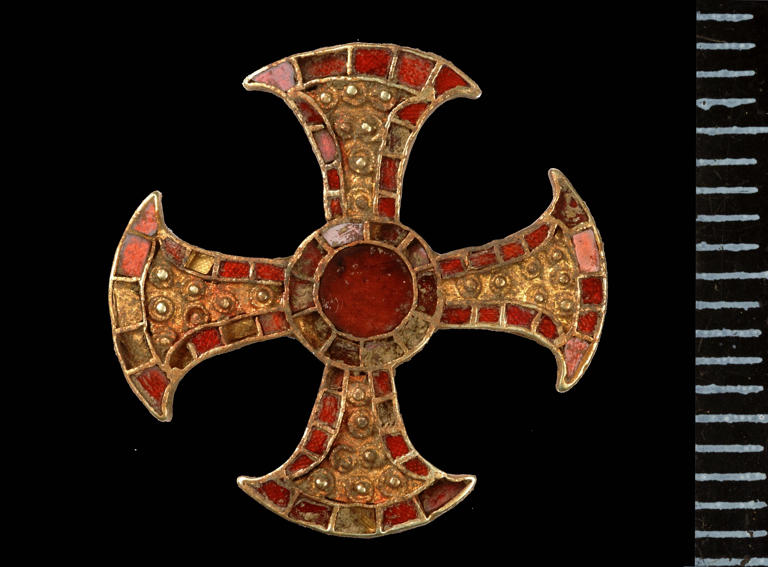
The Trumpington Cross found at the young woman's burial site. The rare gold and garnet cross is only one of five of its kind ever found in Britain. University of Cambridge Archaeological Unit
© University of Cambridge Archaeological Unit
"By combining the scientific results with my work on comparable burials from right across Europe, we suggest that southern Germany is a likely place of origin," Brownlee said.
The analysis also showed that the girl's diet changed slightly between her earlier childhood and when she died, characterized by a small drop in the proportion of animal protein.
"This tells us that the food in her homeland and what she was eating in England was different," Leggett, who is now at the University of Edinburgh, told Newsweek. "This drop in protein could be due to a different food culture in England which wasn't very meat heavy, or perhaps due to adherence to religious dietary rules."
There is still much that we do not know about the girl, including how she died, although there are signs that she was ill throughout her childhood.
"She was quite a young girl when she moved, likely from part of southern Germany, close to the Alps, to a very flat part of England. She was probably quite unwell and she travelled a long way to somewhere completely unfamiliar—even the food was different. It must have been scary," Leggett said in a statement.
Researchers also do not know for certain why she moved so far from home at such a young age, although the researchers outline potential possibilities.
Evidence from this burial and others in the Cambridge region suggest that there was a movement of a small group of elite young women to the area from a mountainous area in continental Europe—most likely Germany—in the latter half of the 7th century.
"She could have been part of the early Christian Church, and moved to be a part of a religious house in England; or she was a high-status bride being sent over to solidify political—and religious—ties between two families or kingdoms," Leggett said.
"By combining the scientific results with my work on comparable burials from right across Europe, we suggest that southern Germany is a likely place of origin," Brownlee said.
The analysis also showed that the girl's diet changed slightly between her earlier childhood and when she died, characterized by a small drop in the proportion of animal protein.
"This tells us that the food in her homeland and what she was eating in England was different," Leggett, who is now at the University of Edinburgh, told Newsweek. "This drop in protein could be due to a different food culture in England which wasn't very meat heavy, or perhaps due to adherence to religious dietary rules."
There is still much that we do not know about the girl, including how she died, although there are signs that she was ill throughout her childhood.
"She was quite a young girl when she moved, likely from part of southern Germany, close to the Alps, to a very flat part of England. She was probably quite unwell and she travelled a long way to somewhere completely unfamiliar—even the food was different. It must have been scary," Leggett said in a statement.
Researchers also do not know for certain why she moved so far from home at such a young age, although the researchers outline potential possibilities.
Evidence from this burial and others in the Cambridge region suggest that there was a movement of a small group of elite young women to the area from a mountainous area in continental Europe—most likely Germany—in the latter half of the 7th century.
"She could have been part of the early Christian Church, and moved to be a part of a religious house in England; or she was a high-status bride being sent over to solidify political—and religious—ties between two families or kingdoms," Leggett said.
The face of a 7th Century teenage girl believed to have been one of England's earliest Christians has been reconstructed.
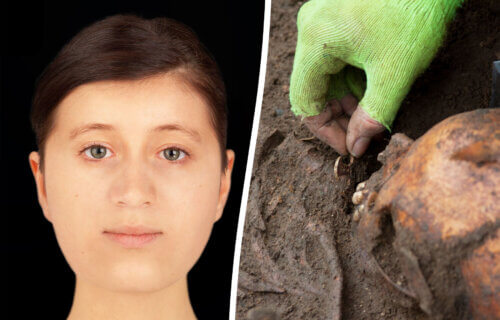
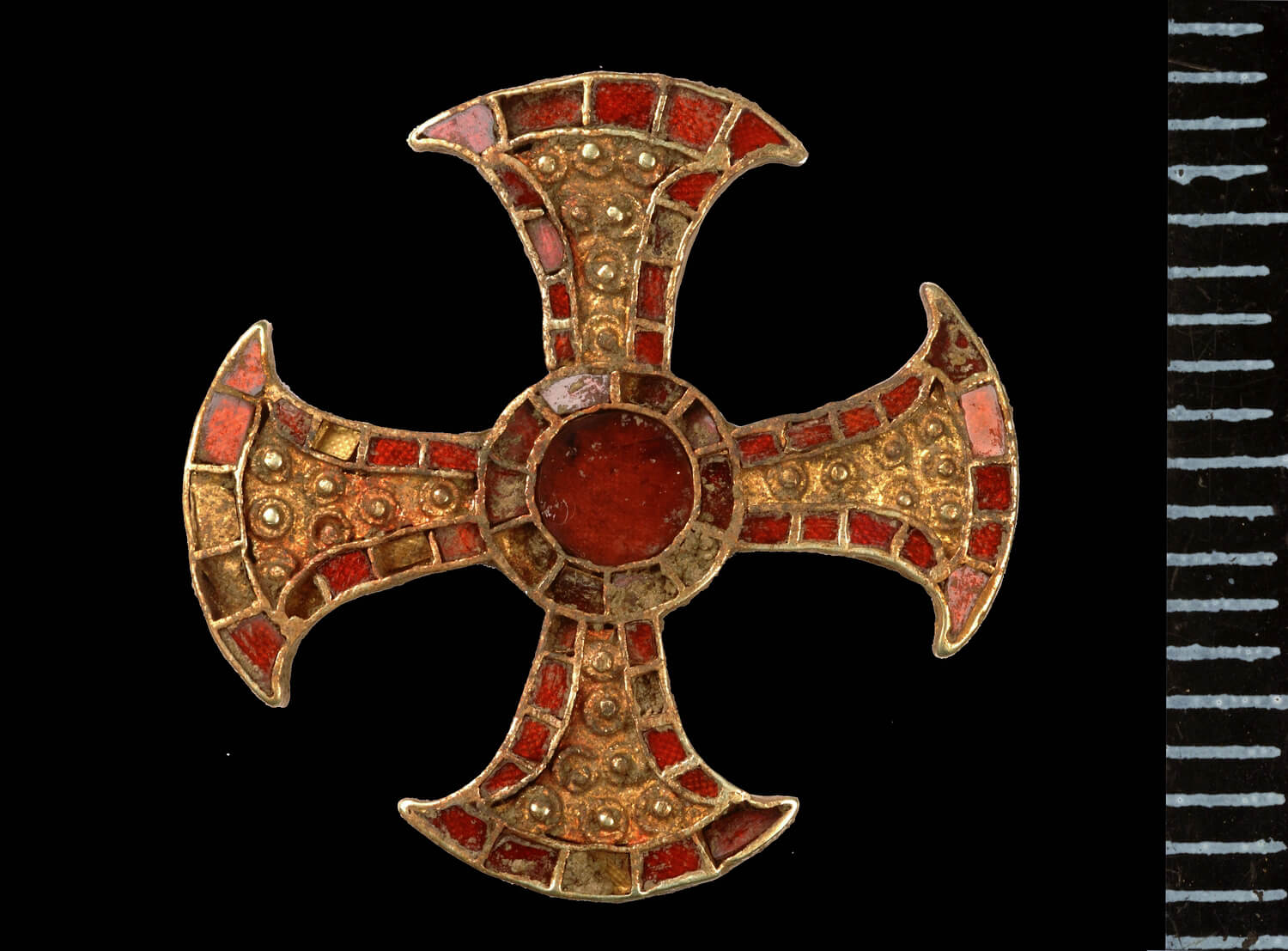
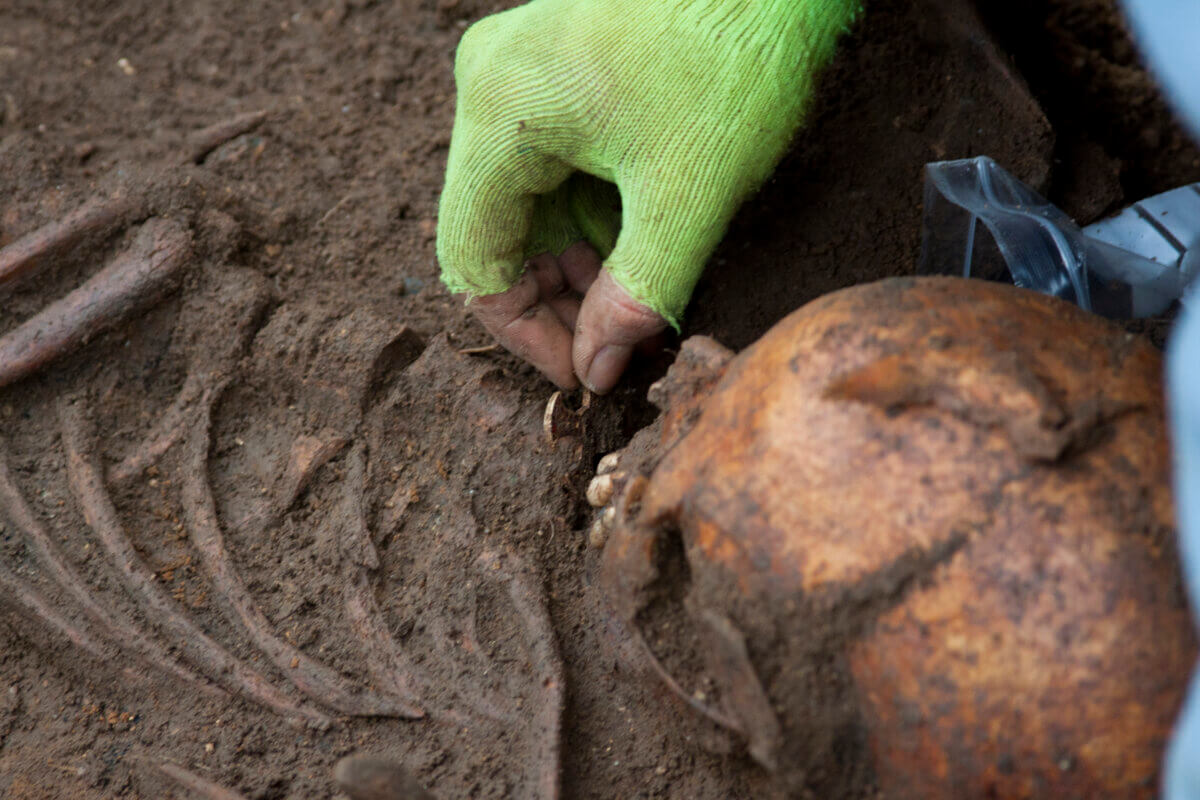
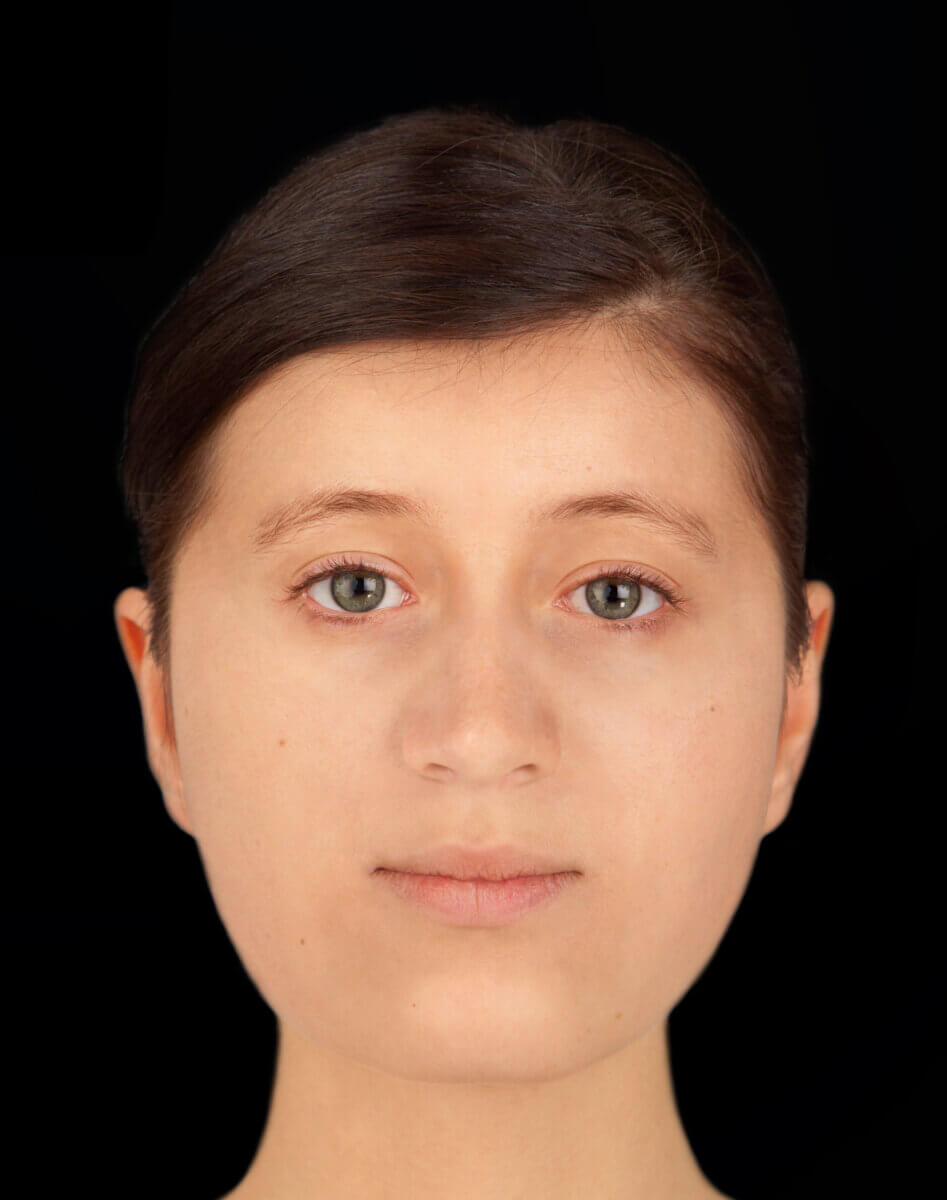
“The story of this young woman goes to the very heart of what our exhibition is all about – new research making visible the lives of people at pivotal moments of Cambridgeshire’s history. MAA holds one of Britain’s most important collections of Early Medieval archaeology and the Trumpington bed burial is so important. It looks like it still has much more to teach us,” concludes Dr. Jody Joy, the exhibition’s co-curator.
The exhibition at Cambridge’s Museum of Archaeology and Anthropology will run until April next year and will also include pottery and textile from the Bronze Age Must Farm settlement, dubbed “Britain’s Pompeii,” as well as the amulet of a feast-loving chieftain, a carving of an Iron Age man and a young friar’s ivory belt buckle.

(Credit: SWNS)
JUNE 19, 2023
by Study Finds
CAMBRIDGE, United Kingdom — The reconstructed face of a teenage girl from the 7th century may reveal what one of England’s earliest Christians looked like. Scientists in the United Kingdom say there’s an interesting twist in her tale. Chemical analysis of her bones and teeth suggest that she emigrated from southern Germany to the U.K. when she was around seven years-old.
Her remains were found near Cambridge, accompanied by a rare gold and garnet cross. This burial is one of only 18 bed burials unearthed in the country, suggesting that she may have had royal lineage. The burial appears linked to two others in the vicinity. Archaeologists speculate that these individuals might have been part of a group dispatched from Germany to convert the Anglo-Saxons to Christianity.
After the analysis of her skull, the face of the girl, who was about 16 years-old, was reconstructed. Her renowned “Trumpington Cross” will be displayed publicly alongside her reconstructed image for the first time.
The teen’s remains were first discovered near Cambridge in 2012. The ornate cross, one of only five ever discovered in Britain, identifies her as one of England’s earliest converts to Christianity.
CAMBRIDGE, United Kingdom — The reconstructed face of a teenage girl from the 7th century may reveal what one of England’s earliest Christians looked like. Scientists in the United Kingdom say there’s an interesting twist in her tale. Chemical analysis of her bones and teeth suggest that she emigrated from southern Germany to the U.K. when she was around seven years-old.
Her remains were found near Cambridge, accompanied by a rare gold and garnet cross. This burial is one of only 18 bed burials unearthed in the country, suggesting that she may have had royal lineage. The burial appears linked to two others in the vicinity. Archaeologists speculate that these individuals might have been part of a group dispatched from Germany to convert the Anglo-Saxons to Christianity.
After the analysis of her skull, the face of the girl, who was about 16 years-old, was reconstructed. Her renowned “Trumpington Cross” will be displayed publicly alongside her reconstructed image for the first time.
The teen’s remains were first discovered near Cambridge in 2012. The ornate cross, one of only five ever discovered in Britain, identifies her as one of England’s earliest converts to Christianity.

The Trumpington Cross. (Credit: SWNS)
Hew Morrison created the detailed image using measurements of the young girl’s skull and tissue depth data for Caucasian females. While the precise color of her hair and eyes could not be determined due to the lack of DNA analysis, the image provides a compelling representation of her appearance shortly before her demise.
“It was interesting to see her face developing. Her left eye was slightly lower, about half a centimeter, than her right eye. This would have been quite noticeable in life,” says Morrison, a forensic artist, in a media release.
A “you-are-what-you-eat” analysis of the young woman’s teeth and bones, conducted as part of a PhD research at the University of Cambridge, has revealed additional intriguing details about her brief life.
Bioarcheologists Dr. Sam Leggett and Dr. Alice Rose, and archaeologist Dr. Emma Brownlee, showed the girl relocated to England from a region near the Alps, likely southern Germany, about a decade before her death. They also discovered that the proportion of protein in her diet declined by a small yet significant amount after her arrival in Britain, a change that took place towards the end of her life. This suggests the period between her arrival and burial was tragically brief.
“She was quite a young girl when she moved, likely from part of southern Germany, close to the Alps, to a very flat part of England. She was probably quite unwell and she travelled a long way to somewhere completely unfamiliar – even the food was different. It must have been scary,” says Dr. Leggett, now at the University of Edinburgh.
Hew Morrison created the detailed image using measurements of the young girl’s skull and tissue depth data for Caucasian females. While the precise color of her hair and eyes could not be determined due to the lack of DNA analysis, the image provides a compelling representation of her appearance shortly before her demise.
“It was interesting to see her face developing. Her left eye was slightly lower, about half a centimeter, than her right eye. This would have been quite noticeable in life,” says Morrison, a forensic artist, in a media release.
A “you-are-what-you-eat” analysis of the young woman’s teeth and bones, conducted as part of a PhD research at the University of Cambridge, has revealed additional intriguing details about her brief life.
Bioarcheologists Dr. Sam Leggett and Dr. Alice Rose, and archaeologist Dr. Emma Brownlee, showed the girl relocated to England from a region near the Alps, likely southern Germany, about a decade before her death. They also discovered that the proportion of protein in her diet declined by a small yet significant amount after her arrival in Britain, a change that took place towards the end of her life. This suggests the period between her arrival and burial was tragically brief.
“She was quite a young girl when she moved, likely from part of southern Germany, close to the Alps, to a very flat part of England. She was probably quite unwell and she travelled a long way to somewhere completely unfamiliar – even the food was different. It must have been scary,” says Dr. Leggett, now at the University of Edinburgh.

The Trumpington Cross is found during the excavation of the burial in 2012. (Credit: SWNS)
Previous analysis revealed that the girl had suffered from an illness, but the exact cause of her death remains unknown.
Her remarkable burial involved her being laid on a carved wooden bed adorned with the rare cross, gold pins, and fine clothing. The ornate gold and garnet cross identifies her not only as one of the earliest converts to Christianity in England but also as a member of the aristocracy, or potentially royalty.
The most famous example of such a cross was found in the coffin of St. Cuthbert, at Durham Cathedral. This ties into the history of the period, as in 597 AD, the Pope had sent St. Augustine on a mission to England to convert the pagan Anglo-Saxon kings, a process that spanned several decades.
“She must have known that she was important and she had to carry that on her shoulders. Her isotopic results match those of two other women who were similarly buried on beds in this period in Cambridgeshire,” Dr. Leggett continues.
“So it seems that she was part of an elite group of women who probably travelled from mainland Europe, most likely Germany, in the 7th century, but they remain a bit of a mystery. Were they political brides or perhaps brides of Christ? The fact that her diet changed once she arrived in England suggests that her lifestyle may have changed quite significantly.”
Previous analysis revealed that the girl had suffered from an illness, but the exact cause of her death remains unknown.
Her remarkable burial involved her being laid on a carved wooden bed adorned with the rare cross, gold pins, and fine clothing. The ornate gold and garnet cross identifies her not only as one of the earliest converts to Christianity in England but also as a member of the aristocracy, or potentially royalty.
The most famous example of such a cross was found in the coffin of St. Cuthbert, at Durham Cathedral. This ties into the history of the period, as in 597 AD, the Pope had sent St. Augustine on a mission to England to convert the pagan Anglo-Saxon kings, a process that spanned several decades.
“She must have known that she was important and she had to carry that on her shoulders. Her isotopic results match those of two other women who were similarly buried on beds in this period in Cambridgeshire,” Dr. Leggett continues.
“So it seems that she was part of an elite group of women who probably travelled from mainland Europe, most likely Germany, in the 7th century, but they remain a bit of a mystery. Were they political brides or perhaps brides of Christ? The fact that her diet changed once she arrived in England suggests that her lifestyle may have changed quite significantly.”

Trumpington Cross burial facial reconstruction created by forensic artist Hew Morrison using measurements of the woman’s skull and tissue depth data for Caucasian females. (Credit: SWNS)
“These are intriguing findings, and it is wonderful to see this collaborative research adding to our knowledge of this period. Combining the new isotopic results with Emma Brownlee’s research into European bed burials really does seem to suggest the movement of a small group of young elite women from a mountainous area in continental Europe to the Cambridge region in the third quarter of the seventh century,” adds Dr. Sam Lucy, a specialist in Anglo-Saxon burial from Newnham College, who published the Anglo-Saxon excavations at Trumpington Meadows.
“Southern Germany is a distinct possibility owing to the bed burial tradition known there. Given the increasingly certain association between bed burial, such cross-shaped jewelry, and early Anglo-Saxon Christianity, it is possible that their movement related to pan-European networks of elite women who were heavily involved in the early Church.”
“These are intriguing findings, and it is wonderful to see this collaborative research adding to our knowledge of this period. Combining the new isotopic results with Emma Brownlee’s research into European bed burials really does seem to suggest the movement of a small group of young elite women from a mountainous area in continental Europe to the Cambridge region in the third quarter of the seventh century,” adds Dr. Sam Lucy, a specialist in Anglo-Saxon burial from Newnham College, who published the Anglo-Saxon excavations at Trumpington Meadows.
“Southern Germany is a distinct possibility owing to the bed burial tradition known there. Given the increasingly certain association between bed burial, such cross-shaped jewelry, and early Anglo-Saxon Christianity, it is possible that their movement related to pan-European networks of elite women who were heavily involved in the early Church.”
“The story of this young woman goes to the very heart of what our exhibition is all about – new research making visible the lives of people at pivotal moments of Cambridgeshire’s history. MAA holds one of Britain’s most important collections of Early Medieval archaeology and the Trumpington bed burial is so important. It looks like it still has much more to teach us,” concludes Dr. Jody Joy, the exhibition’s co-curator.
The exhibition at Cambridge’s Museum of Archaeology and Anthropology will run until April next year and will also include pottery and textile from the Bronze Age Must Farm settlement, dubbed “Britain’s Pompeii,” as well as the amulet of a feast-loving chieftain, a carving of an Iron Age man and a young friar’s ivory belt buckle.
No comments:
Post a Comment